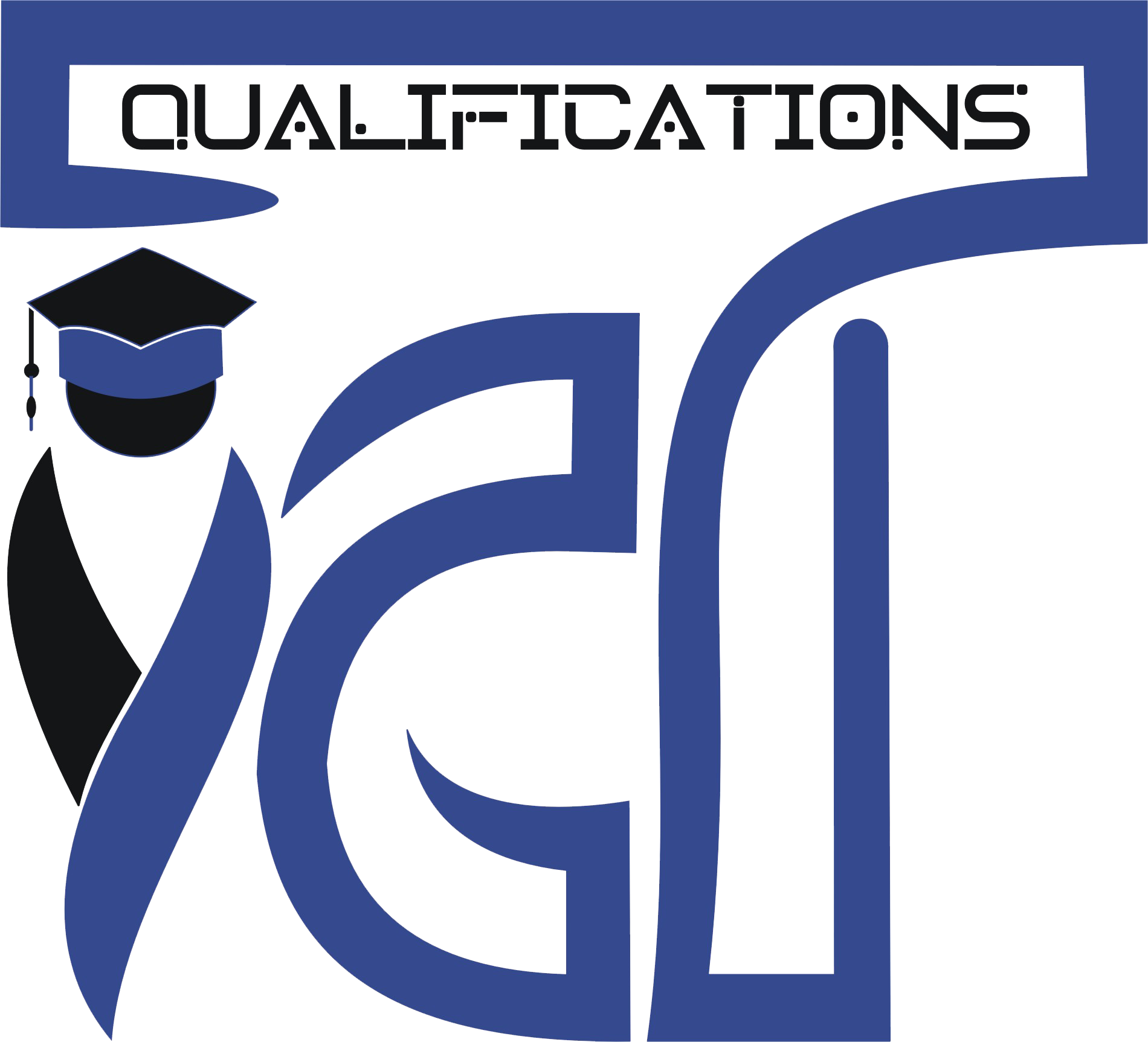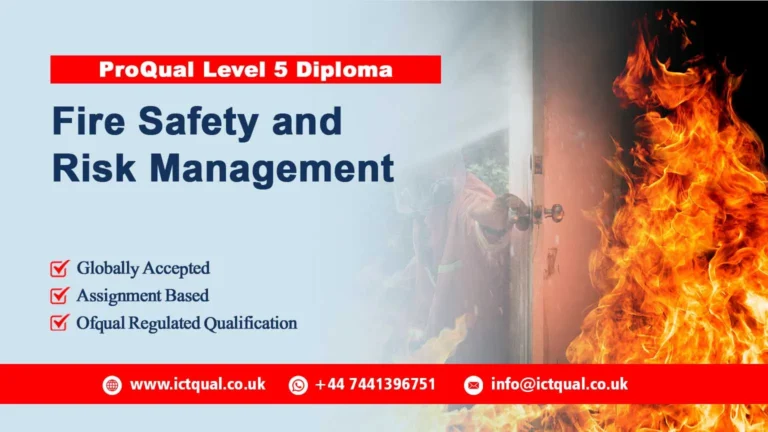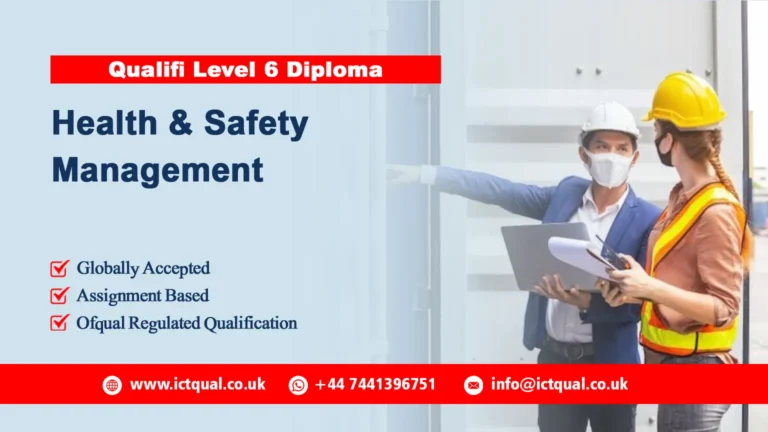In today’s rapidly evolving work environment, ensuring the safety and well-being of employees is more critical than ever. The Qualifi Level 7 International Diploma in Occupational Health and Safety Management is designed to equip professionals with advanced skills and knowledge to tackle complex health and safety challenges in various organizational settings. Here’s a closer look at this esteemed qualification and why it might be the right choice for your career advancement.
The Qualifi Level 7 International Diploma in Occupational Health and Safety Management is a high-level qualification that provides in-depth understanding and expertise in managing occupational health and safety (OHS) systems. This diploma is recognized globally and is aimed at professionals who are looking to further their knowledge and skills in the field of health and safety management.
Achieving a Level 7 diploma can significantly boost career prospects. It opens doors to senior management positions, consultancy roles, and specialized health and safety roles within organizations. The qualification is a testament to your expertise and commitment to maintaining high standards of occupational health and safety.
Enrolling in the Qualifi Level 7 International Diploma typically involves having relevant professional experience or a related qualification at a lower level. Prospective students should check with accredited providers for specific entry requirements and application procedures.
The Qualifi Level 7 International Diploma in Occupational Health and Safety Management is a prestigious qualification that prepares professionals to tackle the complexities of health and safety management in diverse settings. By providing advanced knowledge, practical skills, and international recognition, this diploma offers significant benefits for career development and organizational safety.
If you’re passionate about advancing your career in occupational health and safety, this diploma could be the key to unlocking new opportunities and making a significant impact in your field.
The Qualifi Level 7 International Diploma in Occupational Health and Safety Management is an advanced qualification designed to provide professionals with comprehensive expertise in managing complex health and safety challenges. This diploma delves into the intricacies of occupational health and safety management, offering a deep understanding of implementation standards, risk management strategies, and the role of strategic leadership. It addresses the impact of globalization on safety culture and integrates principles of sustainability within safety practices. Participants will explore problem-solving techniques specific to risk assessment and learn to manage strategic risks within the health and safety domain. Additionally, the course examines the influence of Artificial Intelligence (AI) on risk management and evaluates a wide range of risk control measures across different hazards. Overall, the diploma prepares professionals to lead and innovate in the field of occupational health and safety, ensuring they are well-equipped to handle the evolving demands of the industry.
The Qualifi Level 7 International Diploma in Occupational Health and Safety Management qualification consists of 4 mandatory units of 60 credits for the completed qualification.
Mandatory Units
| Sr# | Unit Title |
|---|---|
| 1 | Management-Driven, Risk-Based Safety Management Systems |
| 2 | Globalisation, Sustainability and Safety Culture Performance |
| 3 | Digitalisation and Incident Investigation |
| 4 | Development as a Strategic Manager |
This course is designed for:
1. Experienced Health and Safety Professionals
For those already working in health and safety roles, the Level 7 diploma offers an opportunity to elevate their knowledge and skills to an advanced level. This qualification is particularly valuable for professionals who want to:
- Expand Their Expertise: Gain a deeper understanding of complex OHS issues, advanced risk management techniques, and strategic health and safety planning.
- Achieve Career Progression: Position themselves for senior roles or specialized positions within their organizations or in consultancy.
2. Health and Safety Managers
Managers who are responsible for overseeing health and safety functions within their organizations can benefit greatly from this diploma. It equips them with the skills needed to:
- Lead Effectively: Implement and manage sophisticated health and safety systems and strategies.
- Drive Change: Effectively address and manage health and safety challenges and ensure compliance with international standards.
3. Consultants and Advisors
Health and safety consultants or advisors who provide expert advice to various organizations can enhance their credibility and service offering with this qualification. It helps them:
- Enhance Their Expertise: Offer more comprehensive and strategic advice based on advanced knowledge and practical application.
- Build Trust: Increase their professional standing and attract higher-profile clients by demonstrating a high level of expertise.
4. Aspiring Health and Safety Leaders
Individuals looking to enter or advance within the field of occupational health and safety management will find this diploma to be a solid foundation. It is suitable for:
- Career Changers: Professionals from related fields who wish to transition into health and safety management.
- New Graduates: Those with relevant undergraduate degrees who seek to gain an advanced qualification to boost their employability and career prospects.
5. Organizational Leaders and Executives
Senior leaders and executives who play a role in shaping their organization’s health and safety policies can also benefit from this diploma. It provides them with:
- Strategic Insight: Understanding of how to integrate health and safety management into broader organizational strategies.
- Regulatory Knowledge: Awareness of international health and safety standards and practices that can influence organizational policy and decision-making.
6. Policy Makers and Regulators
For individuals involved in formulating health and safety policies or regulations, this diploma offers a deeper understanding of:
- Regulatory Frameworks: Knowledge of international health and safety legislation and best practices.
- Policy Development: Insights into creating effective health and safety policies that align with global standards.
Here are the outcomes for each of the listed study units:
- Critique and Apply Occupational Health and Safety Management Standards: Analyze and evaluate various implementation standards of occupational health and safety management, and apply best practices while offering critical insights to enhance their effectiveness.
- Assess Strategic Leadership in Risk Management: Examine the pivotal role of strategic leadership in shaping and guiding risk management strategies, and evaluate how leadership influences the effectiveness of these strategies within an organization.
- Evaluate Globalization’s Impact on Safety Culture: Review and assess how globalization affects organizational safety culture, including the challenges and opportunities it presents for maintaining effective health and safety practices across diverse geographical locations.
- Integrate Sustainability Principles in Safety Management: Understand and apply the principles of sustainability within the safety sector, integrating environmental, social, and economic considerations into health and safety management practices.
- Analyze Risk Assessment Problem-Solving Techniques: Investigate and evaluate problem-solving techniques specific to risk assessment, developing advanced strategies to address and mitigate risks effectively.
- Manage Strategic Risks in Health and Safety: Develop and implement strategies for managing strategic risks within the health and safety domain of an organization, ensuring alignment with overall business objectives and regulatory requirements.
- Evaluate the Impact of Artificial Intelligence on Risk Management: Analyze how Artificial Intelligence (AI) technologies influence and enhance occupational health and safety risk management, including the benefits and potential challenges associated with their integration.
- Assess Risk Control Measures Across Hazards: Critically evaluate a range of risk control measures for various types of hazards, ensuring that controls are comprehensive, effective, and adaptable to different safety scenarios.







